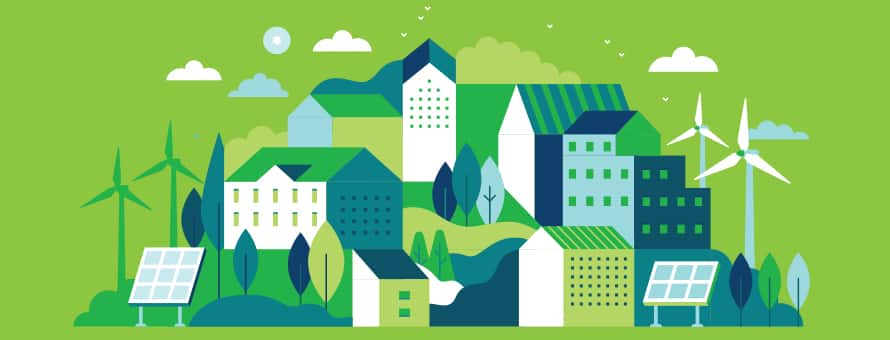5 Types of Renewable Energy and Their Impact on the Environment

Understanding the numbers
When reviewing job growth and salary information, it’s important to remember that actual numbers can vary due to many different factors—like years of experience in the role, industry of employment, geographic location, worker skill and economic conditions. Cited projections are based on Bureau of Labor Statistics data, not on SNHU graduate outcomes, and do not guarantee actual salary or job growth.
As government agencies, corporate leaders and individuals worldwide seek to slow the impact of climate change and create a more sustainable future, several types of renewable energy have seen significant growth.
According to a 2023 report by Deloitte, the U.S. Energy Information Administration expects the use of renewable energy to grow by 17% in 2024, accounting for almost a quarter of all electricity generation in the country.
 “This is definitely a field that is growing quickly,” said Mike Weinstein, director of sustainability at Southern New Hampshire University (SNHU), who also has years of experience in the environmental education and conservation fields. “The urgency is clearer, the technology is available, and governments and other organizations are funding renewables more than ever.”
“This is definitely a field that is growing quickly,” said Mike Weinstein, director of sustainability at Southern New Hampshire University (SNHU), who also has years of experience in the environmental education and conservation fields. “The urgency is clearer, the technology is available, and governments and other organizations are funding renewables more than ever.”
If you’re interested in playing a role in building a more sustainable future for your community and beyond, a career in renewable energy could be a good fit. But first, it’s important to explore the types of renewable energy and their impact on the environment.
What is Renewable Energy?
According to Weinstein, renewable energy is any energy source that is replenished faster than it’s used. Renewable energy is derived from unlimited natural resources, such as sunlight, wind, geothermal heat and the movement of water.
Renewable energy stands in contrast to commonly used fossil fuels, which include coal, oil and natural gas. According to the U.S. Department of Energy (DOE), fossil fuels are finite resources formed over millions of years. Fossil fuel industries drill or mine for these energy sources and then burn or refine them to produce electricity and fuel.
▸ How are Fossil Fuels Bad?
According to the DOE, burning fossil fuels releases carbon dioxide and other pollutants into the air, contributing to global warming. The burning of fossil fuels caused nearly 75% of carbon emissions over the past 20 years, the DOE reported.
 Using more renewable energy plays a crucial role in reducing these carbon emissions, said Dr. Hamed Majidzadeh, an assistant professor of environmental science at SNHU. Majidzadeh previously worked as a program manager for South Carolina Sea Grant Consortium, a state agency that ensures the optimal use and conservation of marine and coastal natural resources.
Using more renewable energy plays a crucial role in reducing these carbon emissions, said Dr. Hamed Majidzadeh, an assistant professor of environmental science at SNHU. Majidzadeh previously worked as a program manager for South Carolina Sea Grant Consortium, a state agency that ensures the optimal use and conservation of marine and coastal natural resources.
“Transitioning to renewable sources is imperative to meet the global target of net-zero emissions by 2040, a step necessary to limit global warming to 1.5°C and ensure a sustainable, low-carbon future,” Majidzadeh said.
▸ Is Renewable Energy the Same as Clean Energy?
While terms like renewable energy, clean energy and green energy are often used interchangeably, they are actually different things, said Weinstein.
“Clean” or “green” energy describes energy sources that don’t pollute the environment. Some forms of clean energy are renewable, such as wind or solar power. However, other clean energy sources, like nuclear power, are not, Weinstein said.
Conversely, even renewable energy is not always the most “green” and can have negative impacts on the environment, said Majidzadeh.
Solar and wind power, for example, can help reduce emissions and lower energy costs, but the land needed for solar farms and wind turbines can impact the surrounding plants, animals and ecosystem as a whole, he said.
What are the 5 Main Types of Renewable Energy?
There are many kinds of renewable energy sources, and they’re evolving all the time. What connects them all, said Weinstein, is that these sources are primarily replenished on their own through the natural functioning of the planet.
Some of the most common types of renewable energy include:
 Solar Energy
Solar Energy
Solar energy is energy derived from sunlight. According to Weinstein, solar energy can be harnessed through anything from small solar panels on an individual house to massive solar farms covering thousands of acres.
Solar power is consistently the fastest-growing sector of renewable energy jobs. According to a 2023 report from the World Economic Forum (WEF), there were nearly 4.9 million solar energy jobs in 2022, accounting for more than a third of all renewable energy jobs worldwide.
 Wind Energy
Wind Energy
Wind energy is typically harnessed with large turbine or turbine arrays in open water or on mountain ridges, Weinstein said. But smaller-scale applications of wind energy are also starting to be used.
 Hydropower
Hydropower
Hydropower relies on the flow of water to generate energy. According to the U.S. Office of Energy Efficiency and Renewable Energy (EERE), hydropower is one of the oldest and largest sources of renewable energy, accounting for 28.7% of total U.S. renewable electricity generation.
 Geothermal Energy
Geothermal Energy
According to the U.S. Energy Information Administration, the breakdown of radioactive particles in the earth’s core produces geothermal energy, which can be used for everything from bathing and heating buildings to producing electricity.
 Biofuels
Biofuels
Biofuels are organisms grown specifically as a fuel source, like trees for burning wood, or ethanol, which is made from corn. Weinstein said that while biofuels are technically renewable because we can always plant more trees, they aren’t the cleanest option since they require combustion to produce energy.
What is the Best Renewable Energy Source?
According to Weinstein, identifying one, best type of clean energy isn't possible. Instead, the best solution is one that is the most sustainable for the community that needs it and is best able to meet its energy demands.
Some parts of the world can easily harvest wind power but may not get enough sunlight to rely on solar power. In other areas, generating wind power may be difficult, but hydropower is abundant.
“It seems fairly clear that a portfolio of renewables is ideal,” Weinstein said. “‘Best’ has to be determined by examining scientific knowledge alongside community knowledge.”
The Growth of Renewable Energy
As countries around the world work to reduce carbon emissions and dismantle their reliance on fossil fuels, the renewable energy field is quickly expanding. Career options in the industry are also growing.
According to the International Renewable Energy Agency (IRENA), jobs in the renewable energy sector worldwide grew from 7.3 million in 2012 to 13.7 million in 2022 (IRENA PDF Source).* Solar power is the fastest-growing sector in the field, according to IRENA, with almost 4.9 million jobs in 2022 — more than a third of the total renewable energy workforce worldwide.*
According to Weinstein, the jobs available in the renewable energy field are varied. Workers are needed to do everything from designing renewable energy systems and installing solar panels to conducting maintenance on wind turbines and advocating for renewable energy in the public sector.
Environmental scientists are also needed for big-picture roles in the industry, said Majidzadeh, helping companies across various industries identify their primary sources of emissions and develop strategies to reduce their carbon footprint.
No matter what kind of role you hope to play in the renewable energy workforce, Weinstein said, having a strong understanding of ecology and how the current energy system contributes to environmental decline is key.
Enrolling in a bachelor’s degree program like an environmental science degree can help you build this critical knowledge, so you can play a role in designing a more sustainable future for your community and beyond.
While human society has always required energy to function, Weinstein said that today's technologically advanced world uses more power than ever before. Finding cleaner ways to generate that power is the role of renewable energy workers.
“Can we get enough energy from renewable sources so that we don’t need to burn fossil fuels?" Weinstein said. "Absolutely, but it requires us to reimagine how we use our energy equitably and responsibly.”
Discover more about SNHU’s environmental science degree: Find out what courses you’ll take, skills you’ll learn and how to request information about the program.
*Cited job growth projections may not reflect local and/or short-term economic or job conditions and do not guarantee actual job growth. Actual salaries and/or earning potential may be the result of a combination of factors including, but not limited to: years of experience, industry of employment, geographic location, and worker skill.
Danielle Gagnon is a freelance writer focused on higher education. She started her career working as an education reporter for a daily newspaper in New Hampshire, where she reported on local schools and education policy. Gagnon served as the communications manager for a private school in Boston, MA before later starting her freelance writing career. Today, she continues to share her passion for education as a writer for Southern New Hampshire University. Connect with her on LinkedIn.
Explore more content like this article

How SNHU Grad Cyndie Ramirez Built Her Second Career in Cybersecurity

California Couple Earn Cybersecurity Master’s Degree Together from SNHU

SNHU Spotlight: Gina Cramer, BS in Cybersecurity Grad
About Southern New Hampshire University

SNHU is a nonprofit, accredited university with a mission to make high-quality education more accessible and affordable for everyone.
Founded in 1932, and online since 1995, we’ve helped countless students reach their goals with flexible, career-focused programs. Our 300-acre campus in Manchester, NH is home to over 3,000 students, and we serve over 135,000 students online. Visit our about SNHU page to learn more about our mission, accreditations, leadership team, national recognitions and awards.


